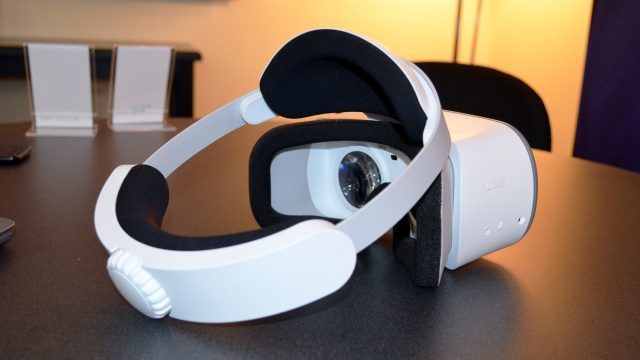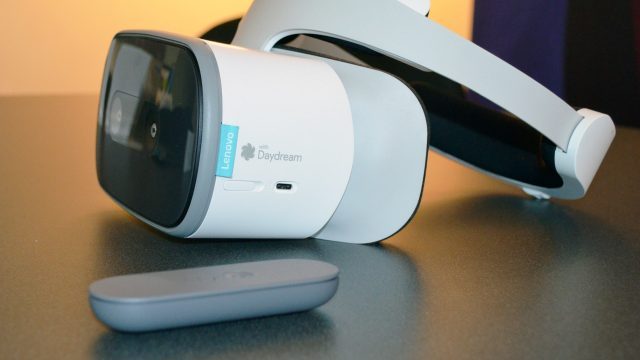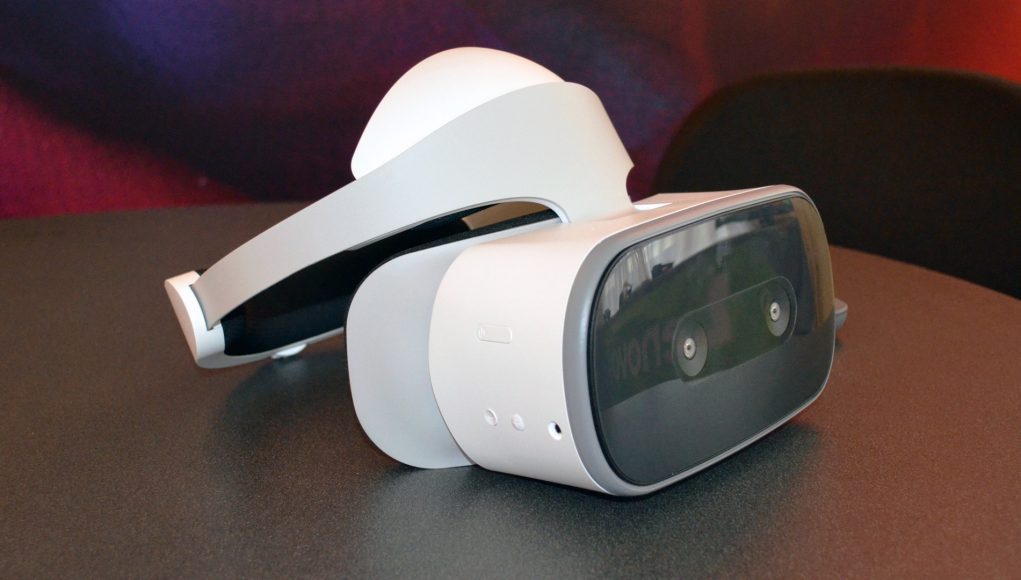At CES 2018 last week, Lenovo revealed the Mirage Solo, the company’s standalone Daydream headset. The new device has everything on-board, including inside-out positional tracking, which means it doesn’t rely on a smartphone or external computer to drive the VR experience. There’s many benefits of standalone headsets compared to smartphone shell headsets, but the Mirage Solo’s price point seems to position it in an awkward in-between segment.
Strong Fundamentals
The Lenovo Mirage is based on Google’s standalone Daydream reference design which we first saw last year. The headset, which is to be priced “under $400,” of course runs a restricted version of Android which directly presents the Daydream VR content store/ecosystem to the wearer (you can’t run any standard Android phone/tablet apps on the headset).
A Step Up

Coming from the Daydream shell headsets, the Lenovo Mirage is a step up in most regards. The optics offer a notably wider field of view, which Lenovo claims is 110 degrees (which would roughly match headsets like the PSVR, Rift, and Vive, if true). The resolution is 2,560 × 1,440, which matches the resolution you’d expect from Gear VR and most other Daydream Ready phones (single display, no IPD adjustment).
Because it’s standalone, not only will it not kill the battery life on your own phone while in use, but the battery can be made larger than what’s in a phone in the first place; Lenovo is targeting an ample seven hours of battery life for the Mirage, and we hope that they’ve been able to use all the extra space to design enough thermal dissipation that users will never again have to worry about overheating (which significantly reduces performance).
Unlike the Daydream shell headsets though, the Mirage Solo crucially adds inside-out positional tracking thanks to a pair of front-facing cameras which allows the headset to track its position while moving through 3D space. This makes the headset much more like high-end tethered headsets, however, the controller itself is still rotational-only tracking; it’s effectively paired to your head position, so it gets a bit of pseudo-positional tracking, but not the real deal.
Tipping the Scales
The Mirage Solo is quite heavy at 645g (1.42 pounds), for comparison: PSVR is 610g, Vive is 470g (555g at launch), and Rift is 470g. The ‘halo’ style strap has been proven to be fairly comfortable on the PSVR and other headsets, however Lenovo seems to have made almost no effort to counterbalance the weight by moving some of it to the back of the headband. It was comfortable enough in my 20 minutes using it, but long-term comfort remains to be seen.
Display & Lenses

Looking through the lenses, the clarity was quite good. As expected for an LCD display, there was almost no mura (color and brightness inconsistency between pixels), which helps a lot with clarity. The screen door effect was minimal and can be a little more or less apparent depending upon certain colors and brightness levels (darker hides it more, brighter tends to show it more). The lenses are indeed Fresnel, and the usual god rays are very apparent in high-contrast scenes. Despite the 75Hz refresh rate and LCD display, I couldn’t spot any ghosting/smearing. I also didn’t notice any flickering (which becomes more apparent with lower refresh rates than higher ones), though there’s a range of flicker sensitivity from one user to the next so your mileage may vary if you are particularly sensitive.
Clarity vs. Rendering Capability
Overall clarity is quite good, potentially class-leading among mobile headsets. The bottleneck to visual fidelity in this case may actually fall more on the rendering horsepower contained in the headset than on any optical or display parameter. High resolution rendering with heavy anti-aliasing is computationally expensive, and it must be used much more sparingly than what’s possible on tethered headsets.
Many of the experiences I tried on the Mirage would have looked significantly better if they had the budget for more anti-aliasing. That’s not to say that things looked bad through the headset, they actually looked quite good, but the graphics and limited anti-aliasing make for a distinct ‘mobile’ look. This means that visual fidelity is likely to range depending upon how skilled developers are when it comes to optimizing their applications to be capable of rendering at native resolution and with effective anti-aliasing, with the best looking titles still falling short of the type of AAA visuals possible on tethered headsets. Though to be fair, the same rule about developer optimization skill applies on tethered headsets as well.
Positional Tracking
The Mirage Solo’s inside-out positional tracking is the same WorldSense tracking that Google introduced for these standalone headsets last year. Using the on-board cameras, the headset is able to accurately derive its own position by observing the world around it (it doesn’t seem that the cameras will be usable for pass-through video). In my short initial experience with the headset, the tracking was entirely competent and I quickly felt comfortable enough to physically move around, taking several steps in either direction.
I didn’t spot any overt latency, but the positional tracking at a very fine level felt a little ‘sticky’, as in—when I kept my head still and then began moving it slowly, it would take just a moment before my virtual view started moving. It feels like this could be the result of tuning to reduce jitter (subtle, static jumpiness caused by the system’s inherent imprecision). It feels subtle enough that the majority of users won’t notice it, especially during typical gameplay (which is a little different from me staring at the floor trying to suss out the intricacies of the tracking system!). It remains to be seen how the system will handle particularly challenging tracking scenarios, like when surrounded by mirrors, windows, and direct sunlight.
The space where I was testing the headset was only about 8 × 8 feet (2.4 × 2.4 meters), and when I stepped a few feet away from the place that I set as the ‘center’, the view faded to black and told me to move toward the center location. For now, there’s no explicit boundary system that would allow you to trace a safe playspace within a room, only the ‘fade out’ feature. Lenovo didn’t mention whether or not the fade out distance would be configurable, but hopefully there will be some options made available at launch, as WorldSense is theoretically capable of tracking very large playspaces. Without a configurable boundary, the headset may be more difficult to use comfortably in smaller playspaces.
T-Rex Simulator 2018

One caveat to the otherwise quite good positional tracking is that the controller itself does not have positional tracking. It only has rotation sensors. Like other Daydream headsets, the controller is thus essentially fixed to your head position, and the rotation is used as input to move a pseudo-arm that rotates from a fixed point. While this feels like an ok compromise for mobile, seated VR (where the controller is primarily used as a pointing device) when you are using it standing up with positional tracking it feels like your arm is superglued to your torso down to your elbow, and you can only articulate your forearm from your elbow joint—that is to say… it feels weird.
What this means in practice is that if there’s a virtual object sitting on a desk in front of you, but your hand isn’t close enough to it, so you can’t simply reach your hand forward like you would in real life (or with other VR systems) in order to grab the object. You’d actually need to move your entire body forward to get your hand closer to the object. This could make for a great T-rex Simulator 2018 game, but it might otherwise relegate the controller to mostly pointing-oriented functions. If that’s the case, it means that the headset’s own 6DOF capabilities become less useful, since the application design is in many ways limited to what the hand-input is capable of.







